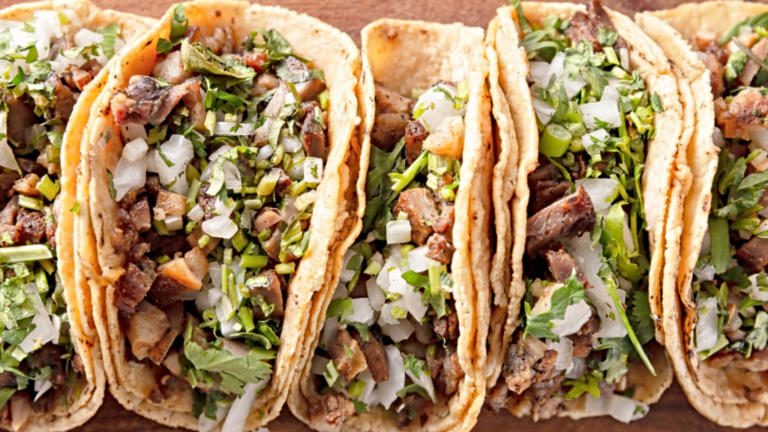“If you had to choose between eating Tacos every day or being skinny for the rest of your life, would you choose hard or soft tacos? » This quote can be seen on Pinterest and Etsy, and, while it seems innocent enough, it implies that tacos are tasty, yes, but also unhealthy. When in fact, tacos can be a healthy food.
The idea that cultural foods (i.e. non-Westernized cuisine) do not meet health standards and should be treated as “cheat” meals is not regulated for Mexican foods. Many different cultures also believe that the foods they eat are not up to par. Amber Alexis Charles, MSPH, RDN, a dietitian based in Trinidad and Tobago, says people in her country view Caribbean foods as unhealthy or bad, due to misinformation about the cuisine. “In health and wellness spaces, we don’t see our foods represented, and if they are, they may be taking center stage. ‘red list of foods,” explains Charles. “There are foods that are ‘Americans or Europeans, and we struggle to figure out how to fit into health spaces and how to use our food.
So, what is a healthy food?
There’s generally a black-and-white mentality when it comes to eating healthy foods, especially here in the United States: Some only imagine whole grains and fresh fruits and vegetables when they think of the phrase. Although foods considered “healthy” provide essential nutrients to the body, they often conform to Western dietary standards, making other cultures feel that their foods are inferior. “I often hear that our cultural diet doesn’t contain many vegetables and that many of our staple foods are unhealthy, like rice and corn,” says Krista Linares, MPH, RD, a Latino dietitian based in Los Angeles. “Often people only count green leafy vegetables and overlook some of the other really healthy vegetable options we offer in Latin cuisine, or think that vegetables have to be their own side dish to count.”
This view ignores other aspects of diet that go beyond macro and micronutrients, including autonomy, culture, preferences, ancestry, and variety. A study on the relationship between food and ethnic identity in a group of Mexican American women view food as an important part of culture and cultural expression. Cara Harbstreet, MS, RD, LD, a dietitian based in Kansas City, Mo., defines a healthy diet based on what it isn’t: “It’s not restrictive, it’s not punitive, it’s not rigid,” she says. “It is not disrespectful or dismissive of individual needs, taste preferences or cultural practices.”
What happens when you call a kitchen “unhealthy”

Calling a cultural food “unhealthy” involves at least a few assumptions: that health is the primary motivator for its consumption and that the food would be more acceptable by Western health standards if it were modified and improved. Whatever the intention, trying to “improve” and “make healthier” a culture’s diet, especially when you don’t belong to that culture, is troubling: you say you are setting the standard by health and healthy eating.
Take the decades-old misconception that MSG (monosodium glutamate), a flavor enhancer used in many different cuisines, is unhealthy and even toxic. This common thought can be traced to a bad review of MSG from the 1960s, when a doctor reported getting sick after eating Chinese food. This escalated into a negative association with the cuisine and perpetuated racism against Asian Americans, even though current research shows There is actually no solid scientific evidence linking MSG consumption to the ingredient’s alleged side effects. (Again, most of the glutamate we consume is found naturally in foods like anchovies, parmesan, tomatoes, potatoes, seaweed and nuts.) “If you hear something enough times, you start to believe it,” Harbstreet says. “If you constantly hear that white rice is inferior or that MSG is toxic, you end up internalizing that message.”
It is possible to add nutrients to cultural meals, but again, this does not mean that the culture as a whole is “unhealthy”, or that even the dish needs to be completely changed. As a dietitian, I believe there are ways to improve the nutrient density or nutrient composition of any recipe through different cooking techniques or ingredient swaps. Still, “it’s important to demonstrate cultural humility before attempting this, and it’s probably best to do it on an individual level,” says Harbstreet.
Once again, by broadly labeling cuisine as unhealthy, you also ignore the broader systemic barriers that can contribute to health – it doesn’t just come down to what we eat. Factors such as housing security, education, income, access to health care, and literacy, among others, also play a role in our overall health and quality of life.
How can we celebrate culture
Recently, I attended a retreat in Tulum, Mexico, a destination with vibrant history and delicious cuisine. But instead of celebrating that, the retreat decided to “make meals healthier”: corn tortillas were replaced with grain and seed bread; white rice was replaced with brown rice and beans. These changes were not listed as an option for allergies or intolerances. To me it seemed like they were decided because Mexican food was not considered nutritious and needed to be healthy.
We can begin to undo this type of mentality by realizing that all foods still provide nutrition and that cultural foods are not inherently unhealthy or in need of fixing. “Embracing your cultural foods is the greatest form of resistance against a society that constantly asks you to change the way you eat and adopt other food cultures,” says Alexis Charles. As an individual, you may want to focus on changing one or two ingredients or foods in a meal, but that is very different from placing an entire culture in an unhealthy category.
